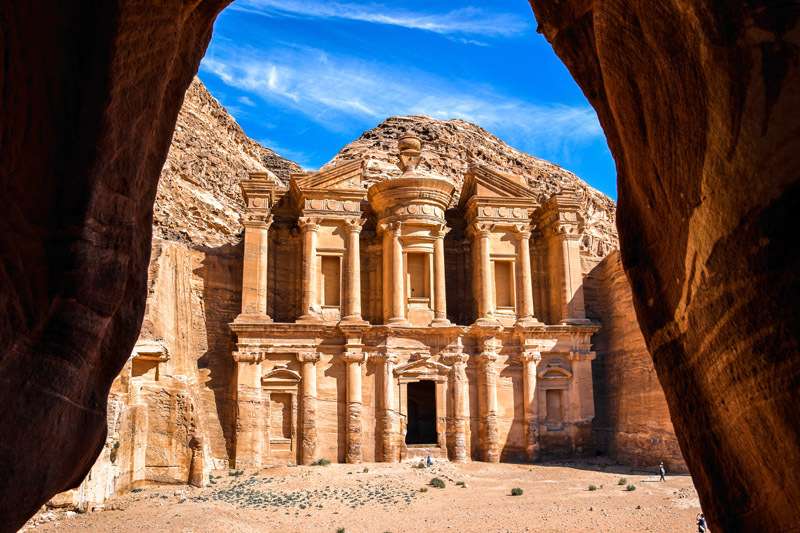
The Nabataeans Info
Between the fourth century BCE and around 106 CE, the Nabatean Kingdom—a strong political entity—flourished in the area of present-day Jordan. It is best known today for the ruins of Petra, which served as its capital city. Scholars typically date the Nabatean Kingdom from 168 BCE, the date of their first known king, to 106 CE, when it was annexed by the Roman government. However, it is clear that a prosperous community was thriving in the immediate vicinity of Petra sometimes around 300 BCE.
The Nabateans were Arab nomads from the Negev Desert who originally accumulated their fortune by trading on the Incense Routes that extended from Qataban to the nearby city of Saba, which was a significant trading center, and on toward Gaza on the Mediterranean Sea. Because they frequently traveled along these routes, they became very familiar with the region, and because they were skilled at identifying and protecting water supplies, they were able to move things more swiftly and effectively than other people.
What to Expect
On most trips to Jordan, you will get to see significant historical and cultural monuments. You will be shown the historic and contemporary features of Amman as well as the vibrant mosaics of Madaba and the historic Nabatean city of Petra. You will enjoy the sensation of hot, salty water on your skin in the Dead Sea, and you can take in Wadi Rum's enchanting beauty and tranquility. Most tour includes stops at the Folklore and Archaeological Museums. Free time to stroll or shop in the city's historic downtown. A stop at Jerash, popularly known as the "City of a Thousand Columns," a Greco-Roman city. Jerash displays the magnificence of Imperial Rome (and is sometimes referred to as the Pompeii of the East). It is regarded as one of the biggest and best surviving examples of Roman architecture outside of Italy.
On your visit, add the "City of Mosaics," or the Christian town of Madaba to the list of places to visit. You can go to the St. George Greek Orthodox Church to see the masterpiece of Madaba, a six-century-old Byzantine mosaic map of the Holy Land that depicts Jerusalem and other cities. You can also go to the Archaeological Park to see the ruins of several Byzantine churches, including the stunning mosaics of the Church of the Virgin. An institute for the preservation and repair of historic mosaics is part of the park complex.
A Visit To the Nabataean Empire
During the first centuries, the Nabataean empire, which straddled the northern end of the caravan route from South Arabia to the Mediterranean, arose as a powerful trading and commercial state. The Nabataeans, who had been nomads in northern Arabia, had already made their way to southern Jordan. Then they caught the attention of Monophthalmos, an ex-general of Alexander the Great who tried in vain to seize their region. At that time, Petra served as the capital of the Nabataean empire and was strategically located at the intersection of many caravan routes that connected South Arabia, China, and India with the Mediterranean region.
The spectacular rock-cut tombs and temples of Petra, which blend features from the architecture of Egypt, Mesopotamia, and the Hellenized West, are still well-known now as they were in antiquity. The Nabataean monarchy expanded its realm northward and briefly captured Damascus. When Roman forces led by Pompey arrived the growth was stopped. The present Jordan, Syria, northern Arabia, Sinai, and Negev deserts were all formerly part of the kingdom. Petra had a population of at least 25,000 when it was a thriving international commerce hub.
History
They established the city of Petra once they were already affluent through commerce since it was difficult to get and was cut from the sandstone cliffs of mountains. Since there was no natural supply of water there and the environment was inhospitable, their choice to construct there has baffled historians and academics for ages. However, the site really makes a lot of sense since it allowed them to monitor the Incense Routes, and tax caravans that passed through their land and further enrich themselves. Its isolation also offered security.
Petra and other Nabatean cities, like Hegra, gradually lost influence over the Incense Routes and the rest of the area after being annexed by Rome. The Nabatean cities' prosperity and reputation deteriorated as a result of caravans being redirected from Palmyra, a city in modern-day Syria, to other trading hubs. By the time of the Arab Invasion in the 7th century CE, the Nabatean Kingdom had been forgotten, and the destruction of Palmyra by the emperor Aurelian in around came too late to revive the Nabatean economy.
related tours

Magic Trip of Jordan
6 Days / 5 Nights
From
$ 688

Taste of Jordan Tour
5 Days / 4 Nights
From
$ 782

Taste of Petra Jordan
4 Days / 3 Nights
From
$ 515
